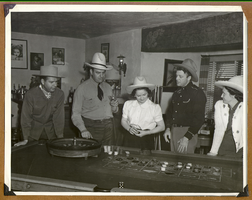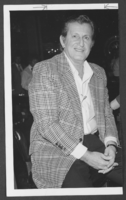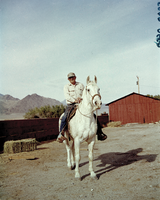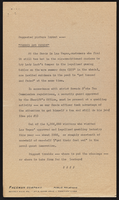Search the Special Collections and Archives Portal
Search Results

Rex Bell, 2nd from right, Bill Frolicki, and two other couples standing by a roulette wheel: photographic print
Date
Archival Collection
Description
Bell Family Scrapbook scanning, Set 4, proofed 11.04.2010 Rex Bell (George Francis Beldam) (second from right), Bill Froelich (second from left) and unidentifed people gambling in the game room of the ranch house at the Walking Box Ranch
Image

Transcript of interview with Laura & Don Garvin by Michael Martocci, March 3, 1979
Date
Archival Collection
Description
On March 3, 1979, Michael Martocci interviewed Laura (born in California) and Don Garvin (born in Goldfield, Nevada) about their lives in Las Vegas, Nevada. The two provide details on their family background, the first sources of water in Las Vegas, and the early city limits. They also describe their early occupations, religion, gambling, the Mormon Fort, and the effects of the Great Depression. The interview concludes with a brief discussion on the development of the Las Vegas Strip and recreational activities.
Text

Photograph of Julie Weintraub, Las Vegas, 1977
Date
Archival Collection
Description
Image

Photograph of Julie Weintraub, Las Vegas, 1980s
Date
Archival Collection
Description
Image
Charles M. Kellog oral history interview
Identifier
Abstract
Oral history interview with Charles M. Kellog conducted by unidentified interviewer on October 03, 1973 for the Ralph Roske Oral History Project on Early Las Vegas. Kellog discusses how he first entered into the gambling business and his occupational history in Las Vegas, Nevada. He also describes the different places that he and his wife had lived and his intentions to begin the University of Nevada, Las Vegas’ first inter-collegiate soccer team.
Archival Collection
Westward Ho! b-roll footage for promotional videos: video
Date
Archival Collection
Description
B-roll footage for Westward Ho promotional videos; people on gaming floor and ordering food at the counter, talking, gambling, eating and drinking. Second segment is shows of plated food available; and ends with shots of a dining room filled with guests. Original media U-matic S, color, aspect ratio 4 x 3, frame size 720 x 486. From The Production Company Audiovisual Collection (MS-00930) -- Digitized audiovisual material file.
Moving Image
Priscilla Alexander oral history interview
Identifier
Abstract
Oral history interview with Priscilla Alexander conducted by Norman Vallata on 1976 for the Ralph Roske Oral History Project on Early Las Vegas. Alexander was born in Southern California, and in approximately 1952 Alexander relocated to Nevada with her aunt and her uncle who worked in the gambling industry. During the interview Alexander discusses gambling ships in Southern California, early above-ground atomic testing, Nevada’s gambling industry, buffets in the early days on the Las Vegas Strip, and working for Howard Hughes.
Archival Collection
Nevada Association of Psychiatric Physicians Records
Identifier
Abstract
The records of the Nevada Association of Psychiatric Physicians (NAPP) document the professional association's membership, activities, and advocacy from 1984 to 2000. The records indicate how NAPP organized the professional psychiatric community in Southern Nevada, held meetings on various public health initiatives, networked with other professional organizations like the American Medical Association and the American Psychological Association, and published articles and newsletters on a variety of psychiatric topics.
Archival Collection

Phil Tobin on horseback: photographic film
Date
Archival Collection
Description
Image

